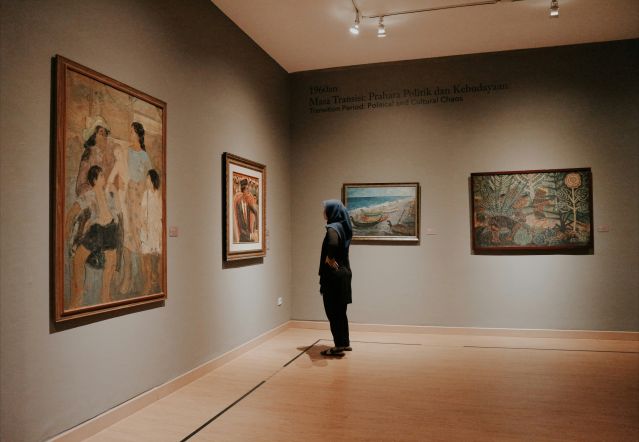Cross-Cultural Psychology
Art Across Cultures: A Tapestry of Diverse Expressions
Exploring the impact of culture on artistic perception and creation.
Posted June 4, 2024 Reviewed by Monica Vilhauer
Key points
- The diversity of artistic expression worldwide emphasizes culture's role in art creation and perception.
- Emotional reactions to art and aesthetic judgments are deeply influenced by cultural factors as well.
- Understanding cross-cultural perspectives on art fosters empathy and inclusivity in the global art community.
This post is written by Hreem Mahadeshwar and Valedeen D'Souza, Monk Prayogshala, Mumbai.
Art is like a deep, shared language that shows us the beauty and complexity of our cultures. Going beyond words, it helps us capture the elements that make each civilization unique and also succeeds in giving us a glimpse into the hearts of those who create it. More often than not, artists use the rich traditions and symbols of their backgrounds to inspire their creations, weaving their cultural stories into their work. The diversity of artistic expression worldwide—from the intricate calligraphy found in Islamic art, which is not just an aesthetic endeavor but also a profound manifestation of cultural and religious significance, to the vibrant patterns and colors in African art, rooted deeply in the continent's rich traditions—highlights the significant role culture plays in art creation. With various kinds of cultures present it isn't hard to posit that individuals from different cultures could perceive art through unique cognitive frameworks developed within their cultural contexts.
This cultural shaping extends into the cognitive processes that underlie artistic expression and appreciation. Culture molds our cognitive frameworks, influencing how we perceive, create, and interpret art. A study found that cultural differences between the East and West profoundly affect perception and thought processes, which in turn can be reflected in artistic expressions. For example, the emphasis on perspective and individual elements in Western art contrasts with the focus on harmony and the relationship between elements in Eastern art. These distinctions not only celebrate the diversity of artistic expression but also underscore how cultural contexts shape our appreciation and understanding of art.
Moreover, the varied use of symbols in art across different cultures adds layers of meaning and complexity to the global art landscape. The meanings attributed to colors, shapes, and motifs, and the storytelling and narrative techniques, vary significantly across cultures, enriching the art world with diverse perspectives. The color red, for instance, may symbolize luck and prosperity in Chinese culture, whereas it might represent negative connotations like blood or danger in some Western contexts. Additionally, storytelling and narrative techniques exhibit remarkable variation across cultural traditions, enriching the world of art with diverse perspectives.
Japanese manga also offers a unique way of telling stories that's different from Western comics. Its special distinctive panel layouts along with its unique storytelling ways provide a rather contrasting narrative experience compared to that of Western comic books. More specifically, manga’s narrative style is deeply influenced by Japanese aesthetics and values, emphasizing the flow of time and the internal states of characters, often through the use of visually quiet, contemplative panels that contrast sharply with the action. As emphasized by Scott McCloud in “Understanding Comics”, Western comics tend to be rooted in American and European traditions. Thus they emphasize the external action and dynamics between characters, with a stronger focus on linear storytelling and direct conflict. The art style in Western comics often highlights realism and proportion, with a vibrant color palette used to capture the attention and convey the mood or tone of the scene. The narrative structure is generally more straightforward, with each panel pushing the story forward through action or dialogue. These cultural differences in symbolism and narrative techniques not only underscore the diversity of artistic expression but also draw attention to the role of cultural context in the interpretation of art.

Cultural backgrounds significantly shape how individuals perceive and engage with artworks, particularly through the lens of attentional processes. Cultural values, aesthetic norms, and familiarity influence what aspects of art capture attention. Cultural priming further accentuates attentional biases towards culturally congruent stimuli. For instance, while Western cultures tend to put more emphasis on the object itself, East Asian cultures pay more attention to the context surrounding the object. By recognizing and embracing the differences between cultures, we can make enjoying art a more inclusive and rewarding experience for everyone.
Also, in many cultures, people feel and show their emotions together, collectively, creating a sense of harmony, togetherness, and shared happiness. This contrasts with cultures that value individuality, where personal reactions to art can include deep self-reflection, intense feelings, and thoughts about life's big questions. This shows that different cultures have their own ways of understanding and showing emotions, which could play a role in the way individuals from various cultures look at a particular artwork. When we learn about these differences, we start to appreciate the wide range of human experiences and creativity even more. Recognizing how our backgrounds influence our views and feelings towards art helps us become more open-minded and respectful of others. This approach to art opens our hearts to the beauty of diversity, bringing us closer to art lovers around the world.
In the rich tapestry of human culture, art serves as a vibrant reflection of our diverse experiences. Rooted in cultural heritage, artistic expression resonates with varied emotions and perspectives across societies. Understanding these cross-cultural dynamics enriches our appreciation of art's universal appeal and cultural specificity. By acknowledging the influence of cultural factors on artistic interpretation and emotional reactions, we cultivate empathy and understanding across diverse cultural contexts. Ultimately, embracing cultural diversity enhances the inclusivity and richness of our artistic experiences, fostering a deeper connection to the global art community.


